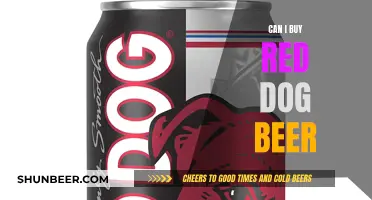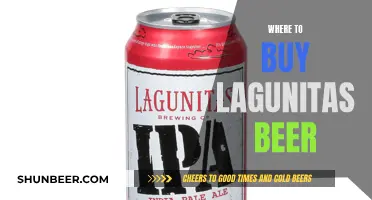
If you're planning a party and want to buy a keg of beer, there are a few things you need to know. First, you'll need to figure out how much beer you need. Kegs come in various sizes, from mini kegs that hold about 5 liters to full kegs that hold about 15 gallons. The amount you need depends on the number of guests and how much they're likely to drink. You'll also need to find a store that sells kegs, such as a liquor store, brewery, or winery, and it's a good idea to place your order in advance to ensure they have what you need. When you go to pick up the keg, bring government-issued ID to prove you're of legal drinking age, and be prepared to pay a deposit for the keg itself, as well as the cost of the beer. You may also need to rent accessories like a tap, bucket, or kegerator to keep the beer cold and dispense it. Finally, make sure you know how to properly store and return the keg after your party.
| Characteristics | Values |
|---|---|
| Keg Sizes | Half barrel, quarter barrel, sixth barrel, Cornelius keg, mini-keg |
| Keg Volume | 1.32 gallons - 15.5 gallons |
| Keg Beer Servings | 14 - 165 12-ounce beers |
| Keg Coupler Types | A, D, G, M, S, U |
| Keg Cost | $70 - $225 (plus deposit) |
| Keg Deposit | $15 |
| Keg Beer Shelf Life | 2 months - 6 months |
| Keg Beer Temperature | 36-38 degrees Fahrenheit |
What You'll Learn

Keg couplers and how they work
A keg coupler is a crucial component of any draft beer system. It is a small but vital piece of equipment that connects the gas and beer lines to your keg. Pressurised gas (either CO2 or nitrogen, depending on the type of beer) flows into the side of the keg coupler through an air line, and the beer flows out through a beer line attached to the top.
There are six different types of keg couplers, each with specifications to accommodate different kinds of beer:
- D-type coupler: This is the most common type of keg coupler and fits all domestic brand kegs. It is designed for US Sankey keg valves, which make up 95% of American beers. D-type couplers are used by major breweries such as Coors, Miller, Budweiser, and other American craft beers.
- U-type coupler: This coupler fits some European keg valves and is mostly used for beers originating from Ireland, such as Guinness, Harp Lager, Smithwick's, and Magners Cider.
- G-type coupler: This coupler is known for its unusual triangle shape and fits some European keg valves. It is used by some British, Dutch, and even a few American breweries, including Anchor.
- S-type coupler: Often referred to as the European Sankey coupler, the S-type coupler is used for popular European brews like Amstel, Pilsner Urquell, Stella Artois, and Heineken.
- A-type coupler: This coupler fits most German keg valves and about half of the Belgian beers. It is commonly associated with brands like Ayinger, Bitburger Pilsner, Franziskaner, Krombacher, and Löwenbräu.
- M-type coupler: The M-type coupler fits some lesser-known German domestic brands like Schneider, Aventinus, Einbecker, and Veltins.
While all keg couplers are similar in appearance and function, it is important to use the right style for the keg you want to tap. Using the wrong coupler type will result in an unsealed coupling, causing the beer to spill out instead of entering the beer line for distribution.
Where to Find Lucky Logger Beer?
You may want to see also

Keg rental for weddings
Renting a keg for a wedding is a great way to provide beer for your guests. Here is a step-by-step guide to help you with the process:
Step 1: Choose the Right Keg Size
First, you need to determine how much beer you will need for your wedding. Consider the number of guests you will have and their drinking preferences. A good estimate is that guests will have 1-2 drinks per hour. The number of drinks a keg can provide varies depending on its size. Here are some common keg sizes and their approximate drink yields:
- Mini Keg: Holds about 5 liters (14 12-ounce servings), great for small gatherings.
- Cornelius Keg: Holds about 5 gallons (53 12-ounce servings), commonly used for soft drinks but can also be used for beer.
- Sixth Barrel (Log Keg): Holds about 5 gallons (55 12-ounce servings), ideal for larger parties.
- Quarter Barrel (Pony Keg): Holds about 7.5 gallons (82 12-ounce servings), suitable for weddings with many guests.
- Half Barrel (Full Keg): Holds about 15 gallons (165 12-ounce servings), the most common size for weddings.
Step 2: Find a Supplier
Look for a local supplier, such as a liquor store, brewery, or winery, that offers keg rentals for weddings. You can search online or ask for recommendations from friends and family. It is advisable to choose a supplier close to your wedding venue for convenience.
Step 3: Place Your Order
Contact the supplier and place your order in advance. Planning ahead ensures that your preferred beer is available and gives you time to make any special arrangements. Provide them with the details of your wedding, including the date, time, and location. Don't forget to ask about any special offers or packages they may have for weddings.
Step 4: Obtain Necessary Permits
Depending on your location, you may need a permit to serve alcohol at your wedding. Contact your local authorities or the state's liquor control board to inquire about the specific requirements and apply for the necessary permits. This step is crucial to ensure your wedding complies with local regulations.
Step 5: Finalize the Rental Details
Work with your chosen supplier to finalize the rental details, including the rental period, delivery and pickup arrangements, and any additional equipment you may need, such as taps, chilling buckets, or a kegerator. Ask about the deposit and rental fees, and clarify the payment process and return policy.
Step 6: Prepare for Pickup or Delivery
On the day of pickup or delivery, ensure that you or your representative is present to receive the keg and sign the necessary paperwork. Have your government-issued ID ready, as proof of age is typically required. Review the rental agreement and ask any last-minute questions to ensure a smooth experience.
Step 7: Enjoy and Return the Keg
Now, you're all set to enjoy fresh draft beer at your wedding! Remember to follow the care instructions provided by the supplier to maintain the quality of the beer. After the event, return the keg and any rented accessories within the specified timeframe to receive your deposit refund.
Renting a keg for your wedding can be a cost-effective and convenient way to provide beer for your guests. By following these steps, you can ensure a smooth process and create wonderful memories for your special day.
Why Mexico's Imported Beer Market is Restricted
You may want to see also

How to store a keg
Storing a keg of beer requires some care to ensure the beverage stays fresh and tasty. Here are some tips on how to store your keg:
Keep it Cool
The ideal temperature to store your keg of beer is at around 38°F (3°C). It is important to keep the beer cold as, in most cases, the beer inside the keg has not been pasteurised. Storing the keg at a higher temperature will accelerate the liberation of carbon dioxide, leading to excessive foam and a loss of flavour. Conversely, storing the beer too cold will result in a flat-tasting beverage as the true flavour cannot escape.
Keep it Dark
Just like bottled beer, kegs should be stored in a dark place, out of direct light. Brown bottles are commonly used for bottled beer to protect the quality of the beer, and cans have become popular for craft beers for the same reason. Basements and garages are good options for storing kegs, as long as temperatures do not fluctuate too much.
Keep the Pressure Consistent
Pressure is just as important as temperature when it comes to storing kegs of beer. If the pressure is too low, the first few pours will be excessively foamy, and the rest will taste flat. Too much pressure will cause the beer to pour too quickly and will also lead to foaminess. The pressure should be kept at a consistent 10-12 psi for American ales and lagers.
Let it Settle
Be gentle with your keg and limit how much you move it around. It is a good idea to let the keg settle for a couple of hours before tapping it. The same principle applies as when you shake a can of beer and then immediately open it. Once the keg is set up, let it sit for at least an hour or two before drinking from it.
Store it Upright
When storing your keg, make sure it is upright and not on its side. Storing a keg on its side can cause issues with the liquid outlet, which is located at the bottom of the keg, and can also make it more difficult to dispense the beer.
American Beer in Punta Cana: What's Available?
You may want to see also

Keg taps and accessories
To tap a keg of beer, you will need a pump. These are also known as picnic pumps or party pumps. You can either pump the beer yourself or use CO2 to do the work for you. The type of pump you need depends on the number of people you are serving and how long you want to spend pumping.
Keg pumps are available from various retailers, including Amazon and KegWorks. They range in price from $24.99 to $220. You can also rent a tap from a liquor store, brewery, winery, or restaurant. The tap rental fee is usually refundable and costs around $50, while the tap cleaning fee is non-refundable and costs around $10-$15.
When choosing a pump, you will need to consider the type of beer you are dispensing. Most American and Canadian domestic brews use a D-system, while other beers use European S-system, A-system, or G-system pumps.
In addition to a pump, you may also want to rent or purchase other accessories, such as a bucket for chilling the keg, a kegerator, or a jockey box. A kegerator is a refrigerator designed to hold a keg and keep the beer cold. A jockey box is a mini cooler that has tubing to dispense the beer through a tap. It can be used to produce instantly cold beer for your guests.
Non-Alcoholic Beer: Who Can Buy It?
You may want to see also

Keg deposits and costs
When buying a keg of beer, you will need to pay a deposit in addition to the cost of the beer. The deposit is fully refundable when the keg is returned. Keg deposits range from $30 to $100, with an average cost of $50 to $70. Tap deposits are usually in the range of $50 to $70.
Some places include the tap and tub rental as part of the keg price, but if you need to rent a tap and a tub, you can expect to pay an average fee of $10 for the tap and $6 for the tub.
When you pick up the keg, you will need to pay the deposit and the cost of the beer. The cost of the beer depends on the type of beer, how much you are ordering, and where you are located. Beers like Budweiser, Miller, and Coors are usually cheaper than microbrews. For example, Budweiser costs $100 for a full keg, while a full keg of Dogfish Head costs about $225.
It's important to note that kegs are typically only delivered to licensed establishments, not private residences.
Amazon Beer Buying Guide: What's Available?
You may want to see also
Frequently asked questions
You can buy a keg of beer from a local microbrewery, liquor store, or online.
The cost of a keg of beer depends on the brand and the size. A half-barrel of Bud Light can cost anywhere from $79 to $139, while a half keg of Stieglitz Grapefruit is $220.
The amount of beer in a keg depends on the keg size. A half-barrel keg holds 15.5 gallons or 165 12-ounce beers, while a mini-keg holds 1.32 gallons or 14 12-ounce beers.
You will need to be 21 or older and bring a government-issued ID, as well as a credit card for the deposit.







